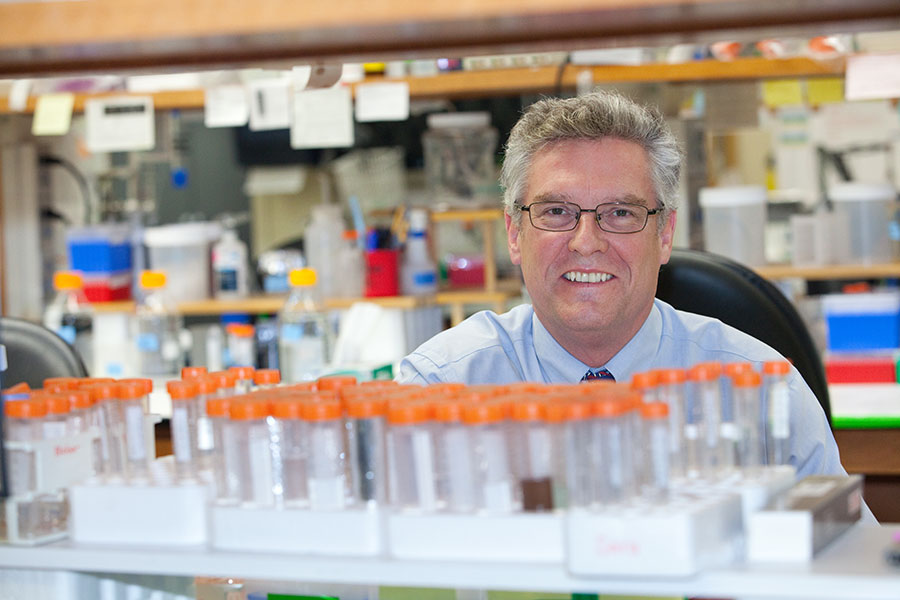
A Florida State University technology developed to treat an incurable eye condition has proven so effective in clinical trials that investors have funded a third portion of Series A financing for Trefoil Therapeutics to support the further creation of treatments for corneal disease.
Professor of Biomedical Sciences Michael Blaber, who developed the treatment and co-founded Trefoil, answered five questions about his research and its future.
Could you explain your research and how it could help treat Fuchs’ dystrophy?
Fuchs’ dystrophy is a degenerative disease of the eye and specifically, the cornea. A layer of cells in the cornea (corneal endothelial cells) controls the flow of water into the cornea. If the layer of corneal endothelial cells is not healthy (i.e., if the population of such cells decreases), then you can get corneal swelling due to an uncontrolled flow of water. The swelling of the cornea distorts vision; and as a progressive disease, it will ultimately lead to blindness.
Corneal endothelial cells can respond to certain growth factor proteins. Such growth factors can stimulate corneal endothelial cells to divide and grow, thereby effectively healing the cornea. We have been studying one such growth factor, called fibroblast growth factor-1 (FGF-1). It was not considered a good candidate as a drug since it was an unstable protein that could not be stored, transported or reconstituted (as is needed for a practical pharmacotherapy). We engineered a few changes to the protein sequence that eliminated such undesirable properties, leading to an effective treatment.
What first drew you to this area of research?
Our main area of research is in protein structure, stability and folding. We were actually using FGF-1 as a model system for general studies, not really aware of its therapeutic applications in regenerative medicine. Once we realized its utility as a drug, we became aware of the limitations relating to stability and aggregation that prevented its practical use. At that point in our studies, we had actually generated several hundred mutants examining aspects of stability and folding. We looked at these mutants and asked whether some had been stabilized without affecting the protein functionality. We then filed patent applications for their utility as potential drugs.
When did you realize this was something that could be taken to market?
In the late 1990s, we became aware of studies using FGF-1 to treat heart failure. In this case, the growth factor was being used to regenerate coronary blood vessels that were blocked. There are many nuances associated with drug development, one of which is protected intellectual property (i.e., patentable compounds). In the case of the heart study, the natural FGF-1 protein was being used. FGF-1 was discovered and characterized in the 1970s and 1980s and is considered to be in the public domain (and therefore not a patentable compound). Since the natural protein cannot be patented, technology related to its application is not particularly attractive to venture capital (VC) companies that fund drug development. The reason for this is that without a patent on the growth factor compound, a generic company can immediately produce and sell it. However, while the natural protein is no longer patentable, a mutant protein (having one or more amino acid changes) is potentially patentable. Thus, with protected intellectual property (IP), which means an issued patent, drug development is much more attractive to VCs.
How do you balance your role as a professor and your role as co-founder of a company?
My skill set serves me well as a faculty member; conversely, I don’t have the skill set to effectively run a business, and therefore, I don’t try to. I limit my interactions with the company to scientific consultations in my area of research – i.e., protein structure, stability and folding. It’s also important to me not to get involved in contract research. Such work can prevent lab members from freely publishing (which is key to their career), and also places pressure to reach some milestone by some deadline (which might not be achievable due to teaching or administrative commitments as a faculty member). So, I would say, the best arrangement is arm’s length; however, effort must be made if success is going to be forthcoming.
Why is it important for researchers to take that extra step and see how their work can be applied, potentially taking them into the entrepreneurship world?
I tend to view this question from the standpoint of a taxpayer. University research is essentially paid for by taxpayers (either state or federal). Research is, fundamentally, the generation of knowledge, and in a College of Medicine that knowledge is obviously related to human health. The fate of such knowledge is either that it is put to work (and provide a health benefit to the taxpayer), or is wasted (i.e., becomes useless knowledge). If university researchers are going to take public funds, I believe they have an obligation to the public to do their utmost to demonstrate a benefit of the knowledge that such funds generate. However, it is a long and arduous path to move basic research from the lab to the bedside, involving diverse expertise (e.g., patent writing, VC connections, and so on). The university infrastructure must provide such expertise, otherwise, research knowledge will ultimately be wasted.



